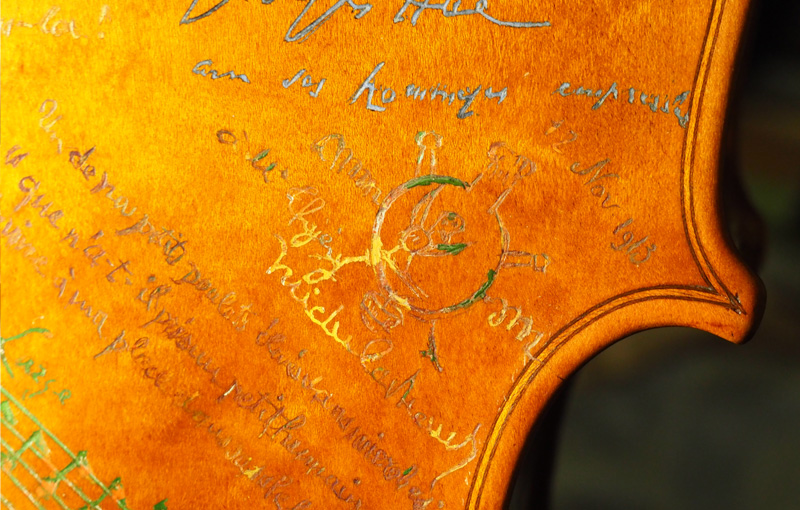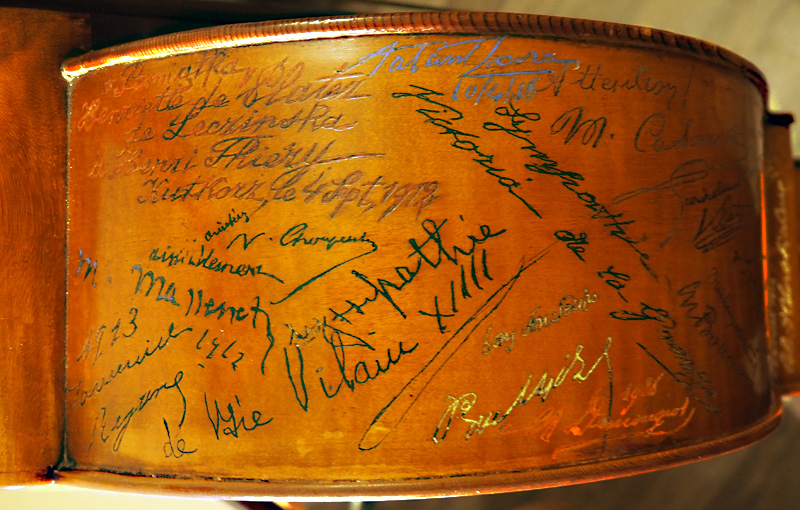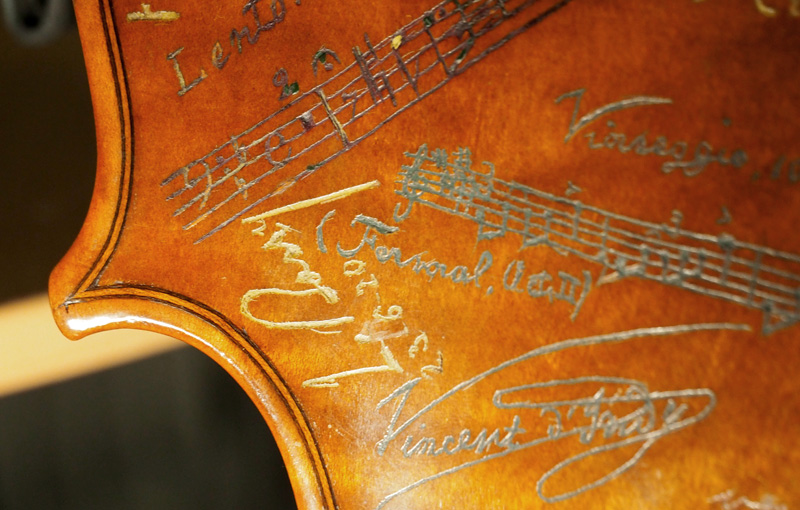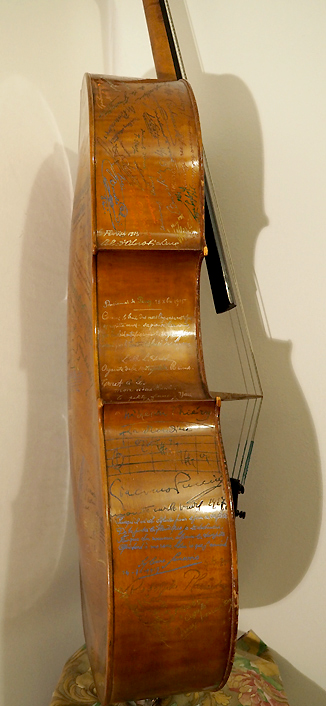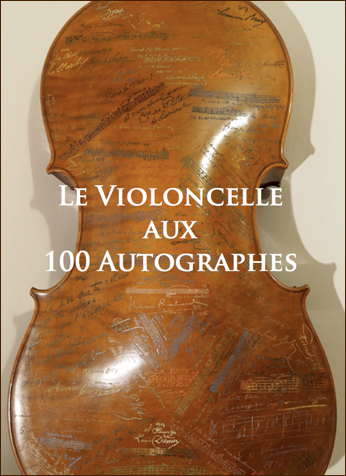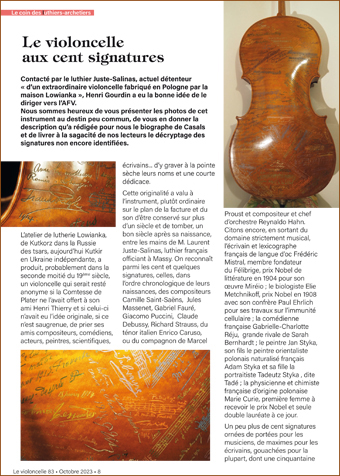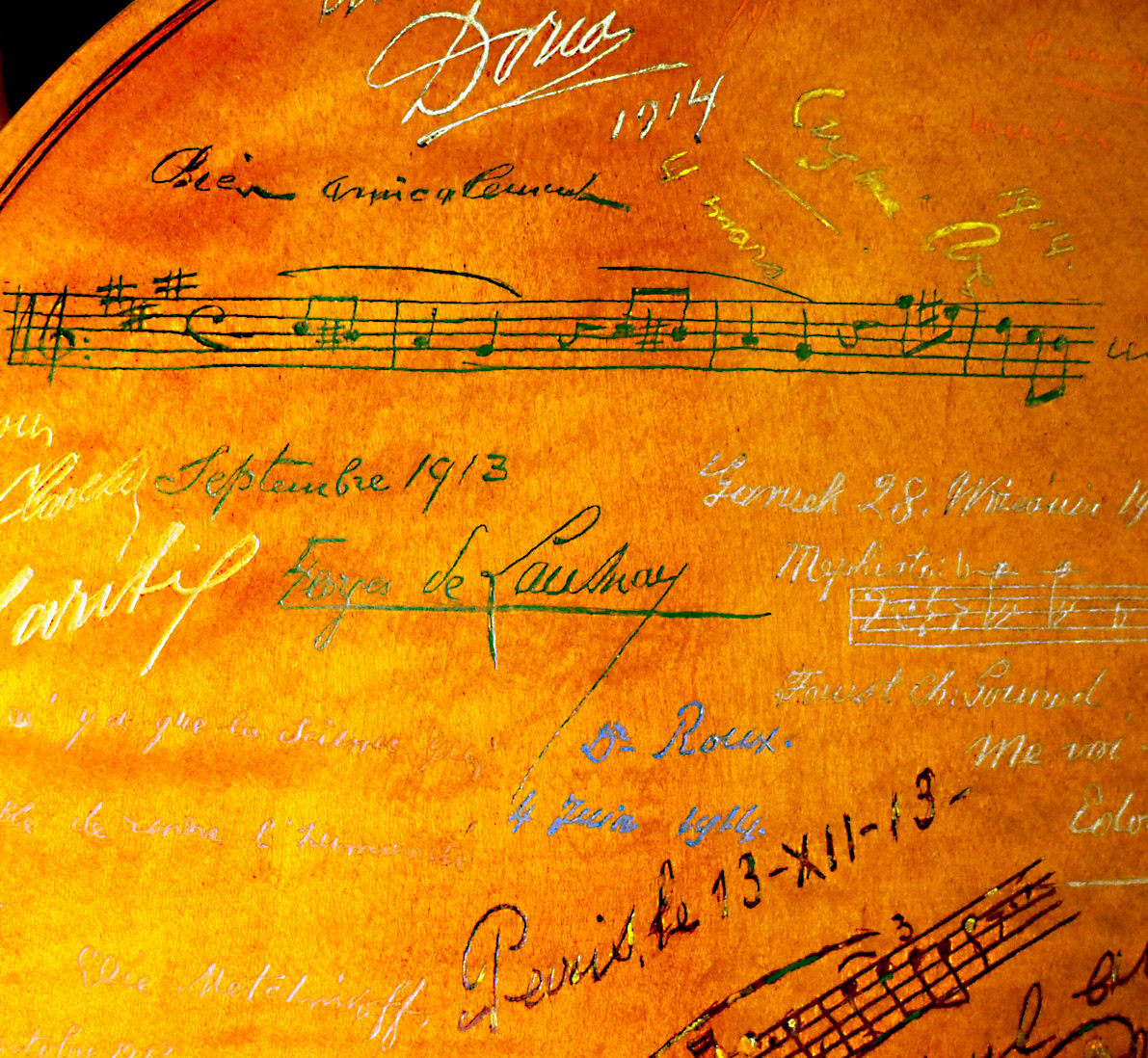
The Extraordinary Autographed Cello
Unravelling the mystery…
It all began on an ordinary day, in my workshop…
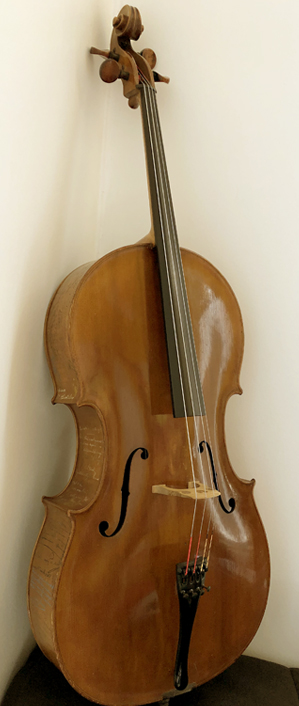
How can
I help you, sir?
It all began on an ordinary day, in my workshop. I was concentrating on the delicate finishing touches to a new violin of my own making, when the door bell rang. An elderly gentleman ambled across towards me, carrying what was evidently a cello case. I put my work down with a sigh.
How can I help you, sir?
– « Well… He fumbled with the case. I have a cello, you see. It was left to me by my grandfather. It’s been in our family for years, but now I’m ready to sell. »
And he duly pulled out the instrument, which seemed in fair enough condition. The varnish was an attractive golden brown and well kept, though not exceptional.
« I’ve come a long way out of town to find you, you know. I went up and down the Rue de Rome. I’ve been to every violin maker in Paris. But none of them believe me. You see… »
And then he turned the cello around.
The back was covered with signatures.
All picked out in different colours. It was beautiful, certainly, but also one of the most bizzare things I have ever seen in my life. I didn’t know what to say. I peered at the signatures. One in yellow caught my eye.
« Good grief. Is that … Debussy? »
« Claude Debussy, yes. He signed it himself. And look here… Camille Saint-Saens. Giacomo Puccini… there are many more. Those Paris Luthiers! They didn’t believe me. No-one believes me, they either say it’s ruined an antique instrument or that it was all just stencilled from an autograph book. But it’s absolutely genuine. It was my great-grandfather’s work. His life’s passion. He travelled all over Europe with this cello, asking people to sign it. Look, there’s Richard Strauss…»
« And is that… Marie Curie? »
« Yes, he didn’t just go after musicians you know. All the famous people of the day are here on my cello. And not just their autographs. Quotes and dates too, look ‘Colonel Ponsonby’… »
« I’m sorry, but I’ve never heard of him. »
« He was once the great Queen Victoria’s private secretary no less! I checked with the Ponsonby family – look, it says ‘Buckingham Palace, London’. Now why on earth would anyone fake that? »
I was intrigued. I decided to take the gentleman at his word and I requested that he leave the cello with me, so that I could examine it carefully and list many the signatures. Over the coming week I deciphered more famous names, but still there were others, like Ponsonby, that were more obscure; obviously notable in their day, but now forgotten.
Eventually I offered the gentleman a fair price, taking into account that the instrument was in need of urgent restoration, with a crack on the sound board that needed immediate repair. It was now up to me to find a way of authenticating the signatures. If they were indeed genuine, then the instrument was beyond price. It was a risk, but I was already enchanted by this extraordinary autographed cello and longing to discover its secrets.
I managed to contact Alain Buquet, a celebrated graphologist regularly working for the Paris Law Courts, and one of the handwriting experts who had analysed the infamous anonymous letters in the tragic case of Grégory Villemin.
Buquet suggested that I start by hunting in the archives of the Bibliothèque Nationale. It should be possible to track down a variety of genuine contemporary autographs of the most famous names on the cello, using letters and other legal documents bearing signatures.
I spent many hours at work there and came away with various useful examples of the signatures of Gabriel Fauré, Debussy, Reynaldo Hahn, Richard Strauss, Camille Saint-Saëns and Marie Curie.
After a month of reflection, Monsieur Buquet wrote a report, stating that all the signatures on the back of my cello were indeed genuine. They had evidently been etched in, using a fine stylus.
The label inside states.
My cello has had a long voyage through both time and history. I was intrigued by the notation on its interior:« Cadeau du Comte et de la Comtesse Leczinskiej à notre ami Henri Thierry Kutkorza Violoncello Lowianka 1912. »(« A gift from the Count and Countess Leczinskiej to our friend Henri Thierry. Cello manufactured by the house of Lowianka, Kukorza. »)
This places my cello’s origins in the pre-revolution Russian empire. Kurtorza is now in modern day Ukraine, but back then would have been part of Poland. Indeed, the first signature is that of Comtesse De Plater de Leczinska, a descendant of the Polish nobility…
Description
The cello itself has a spruce soundboard, of medium thickness. However, the back of the instrument is actually made of norway maple (acer platanoides). This leads me to believe it was chosen especially, or possibly made especially for the autographs, as this variety of maplewood is particularly easy to engrave.
Despite the different woods used, the cello has a beautiful sound. I offered the instrument to a local professional musician to play and he was impressed by its rounded sonority. But of course, the fact that instrument plays so well is merely a bonus; its unique peculiarity is the dazzling array of autographs that decorate its back.
It would seem that once Monsieur Thierry had returned to Paris with his new gift, he set about the bizzare task of accosting almost every famous person of the day and requesting that they sign it. One can only imagine how delightfully eccentric this must have seemed – surely the reason why so many stars of the belle epoque were content to oblige him.
Between 1912 and 1920 he avidly persued the greatest musicians, writers, artists, scientists and actors of the day, thus creating his own personal museum piece of autographs, with the etched signatures coloured using gouache. In addition there are bear dates, locations and quotations.
Here is a list of the signatures:
La Comtesse De Plater de Leczinska
Jules Massenet
Richard Strauss
Camille Saint-Seans
Col. Ponsonsby (once secretary to the then late Queen Victoria)
Giacomo Puccini
Claude Debussy : Si j’étais Dieu j’aurais pitié du cœur des hommes (Pélléas et Melisande)
Lucie de Launay Léon (actress) : Le mot que tu retiens est ton esclave, celui qui t’échappe est ton maître.
Alexandrine Emile Zola / Déc. 1913: Ces lignes sont de l’écriture de mon cher mari : Oh ! mère bien aimée, oh ! père qui m’accueille.
Il n’y a que la science qui est capable de rendre l’humanité heureuse. Elie Metchnikoff (zoologist and nobel prize winner) / 27 octobre 1913.
Il ne revint jamais là-bas au large de la sombre Islande, avaient été célébré ses noces avec la mer. Pierre Loti (writer)
A beautiful voice is the gift of God. Adelina Patti / 1914
La fille de Mme Angot : Elle est tellement innocente qu’elle s‘attaquait au pouvoir sans le connaitre et sans savoir combien elle était imprudente.
Charles Lecocq / 13 juillet 1916Fasse ami cette douce mélodie qui me fait rêver et oublier la vie, viens mon faune bel artiste mystérieux, viens laissons cette terre et montons aux cieux.
Andrée Touchard / 7 mai 1920.
Conclusion at the bottom of the page…
